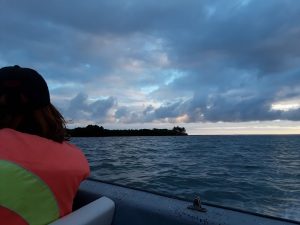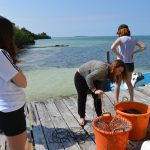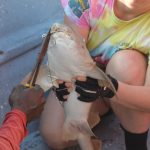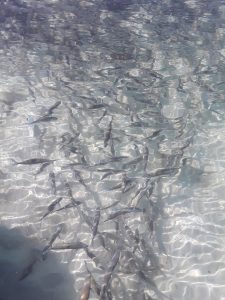Day 0: On the Road

The patchwork of farmland and jungle in the Belezian countryside. Agriculture and ecotourism are the two largest industries in the country, and interests often clash.
Today marks my first trip outside of the contiguous US. I woke up in NH around 2:30 am for my 6:00 flight out of Boston, and touched down in Belize City around 3:30pm (I lost 2 hours crossing a time zone). I could almost feel the humidity cling to my skin as we touched down on the green and gold Belizian countryside. Customs confiscated the banana in my backpack (oops!). Despite a few delays, I still made it to the Belize City Airport so far in advance, the airport bumped me up to an earlier flight to Dangriga–right into the copilot’s seat! As the little Cessna climbed in altitude on its way from Belize City to Dangriga, I couldn’t help but think “We’re not in Kansas anymore, Toto.” Palm trees, rather than pine trees, stuck out from the broad-leaf forests below. Jungle checkered the land side by side with agriculture. It was green for miles and miles and miles.
Except, of course, when we flew over the ocean. We flew over open water for at least 10 minutes. I stared straight down at the water, rather than the horizon like the other passengers. I almost believed I could see sharks in the water below.
The resort was a short walk down a dirt road from the ramshackle Dangriga Airport. The woman at the desk guessed my name! Slow day, I guess. In fact, this was my first experience with “island time.” Theresita handed me a form to check into my room, but constantly asked me questions while I filled it out. “Where are you from? What are you here for? How were your holidays? Have you seen any good movies?” She was obviously in no hurry, and I decided I wasn’t either. I chatted with her about how she grew up in Belize City and wants to go back, but her kids are here in Dangriga. I hope she can get out of there someday.
Once in my room, I snacked on a few airplane pretzels and fell asleep around 8 pm after an exhausting day. I hope a good night sleep will make me feel more adventurous the next day.
Day 1: A Belizian Welcome
I awoke today to the sun glowing through the palm trees that waved good morning outside my window. Palm trees of the greenest green fringed with gold framed a postcard perfect dock on the sapphire ocean. I plopped down on a bench with my binoculars (tourist mode activated!) and in 20 minutes, I promptly saw 5 birds I’ve never seen before: great-tailed grackle, magnificent frigate birds, little blue heron, and great tinamou! Not to mention the green iguanas, reddish squirrels (their legs were longer than those in America—maybe a heat adaptation?) and tiny tiny anoles. The biodiversity is already astounding! I can’t wait to see more on the island.
I ended up running into, and eating lunch with, three women (Nadine, Ruthanne and Nancy) who were also on the trip, who introduced me to Megan. Megan is the PhD student leading our trip: a bright and bubbly twenty-something just 2 years into her degree. I can tell she will make a great leader. The remaining 4 people rolled off of planes in the next few hours–turns out it’s an all-girls mission! I had a great time chatting with the women I’d be spending the next week with over a plate of chicken and cheese stuffed jacks. I couldn’t have asked for a better welcome.
Around 4, we all clambered onto a simple fishing boat (nothing more than a few removable benches—which we were glad for once we started using it for fishing!). The boat ride to Glover’s Reef (the site where the research took place) was a little less

Approaching Middle Caye! Glover’s Reef (and the marine conservation zone we worked in) is surrounded by a ring of islands. Middle Caye is in the southeastern corner. Though this caye is owned by the World Conservation Society (WCS), the island next door supported a small resort.
than an hour and half. The seas were not rough, but the waves were large enough to make my stomach clench. I quickly forgot the rocking boat once I spied another sign of life on the open ocean: Magnificent Frigatebirds!
Palm trees waved welcome as we pulled up to Middle Caye. Ken, the station manager, gave us a little tour of the Glover’s Reef field station after we dropped our bags off at our bunks, then led us to dinner. Four brightly colored wooden buildings stand guard around the sandy courtyard. In the mess hall, 5 wooden bench tables were set with ketchup, jam, peanut butter and utensils. After a dinner of tortillas and barbecue chicken wings, we settled into our bunks, each fitted with just a sheet smelling faintly of mothballs. It was more than enough to drift off to sleep.
Day 2: Tsunami!
I woke up the next morning before the sun rose. It was still dark at 6:30 am, but brightened up quickly–that’s what happens with only the open sea between you and the sunrise! Breakfast–served at 7 am–was buns with a blackbean paste, with fresh watermelon and papaya on the side. I quickly fell in love with the Belizean cuisine served at the field station.

The Earthwatch volunteers pausing the almond tree. We found a couple edible nuts–though the fruits were like golf balls, the almonds were only about the size of a grain of rice!
Megan laid out the day for us. We were still waiting on the all-important permits to work within the reef’s conservation zone, so we took the morning to learn (what seemed like) everything Megan knew about reef ecology. We took a short walkaround the island where Megan pointed out many natural wonders: Almond trees! Mangroves! Black iguanas! Oh my! I was astounded at the sheer volume of coral around me. Brain corals piled by staircases, alien-looking branches scattered on the path. Hermit crabs crossed the path like elderly men out for a morning stroll. The crabs have great taste in real estate too: every time I picked up a pretty shell for a keepsake, I found bright red and purple claws curled inside.
Megan also trained us on the equipment, instruments, and techniques we had to use when “working up” a shark once caught. For her study, we needed very specific pieces of information: sex, size, a tag number, and tissue samples. That might not seem like a lot, but when dealing with hundreds of pounds of pure aquatic muscle, efficiency is key. To keep organized, our team quickly came up with an assembly line to make “work-up kits” for each shark, that contained one of every item. We made 30 in about an hour, and Megan thanked us profusely, as it would have taken her half a day to do the same thing.
After packing away all the fishing supplies, we ate dinner (grilled chicken and coleslaw!), and I decided to sit near the classroom with wifi to keep in touch with friends from home. Around 8:45, I felt my bench shook a bit. Weird, I thought, as I was sitting on a bench of concrete! Not a minute later, a thick Creole accent called out. “Aye, mon, I think that was an earthquake!”
I’d be lying if I said my heart didn’t jump in my throat. I had been through earthquakes before, but in the ocean it wasn’t the earth I was worried about anymore. I did the worst thing: check the news. It turns out 7.6 earthquake off the coast of Honduras (just south of Belize). Tsunami warning issued for all places within the 1000 km of the epicenter. Glover’s reef was only 500 km away.
The news spread quickly around the station. A few younger guys in the Belizean coast guard came out to listen as well, and they translated the Creole discussions for me. Tsunami warning. Belize City evacuated. Water receding up north. Again, I was pretty nervous… But all the locals—Ken, Bert, the Belizean coast guard–were cracking jokes like Mother Nature was pulling some prank on them! It turned out that they had the right idea. There was no wave, no evacuation, just a bonding experience. I fell asleep feeling every shudder of the beach house and every crashing wave like a thunderstorm.
DAY 3: Biodiversity Bonanza
I went for a walk on the trail today, to check out any sign of the non-existent tsunami. No such sign–the sea was flat with just
a few white caps. I spied 3 frigate birds, a Palm Warbler, and a few buffy brown birds I could not identify.
Today, we went longlining! We set up two buoys with a longline between them. Every 10 feet or so Megan would clip a gangion, a length of wire with a hook on the end, to the longline. Special circular, quick-rusting shark hooks made it less likely for a shark to swallow the hook and less dangerous if it did happen. This also meant that a brand new basket of hooks would have to be replaced every a few weeks, which got expensive quickly. Each line could only be left in the water about 90 minutes, because stingrays could die if left alone on the line. These were just a few of the sacrifices the researchers made for the safety and respect of the animals they study.
Most of our time on the water was spent baiting these lines with fish Bert caught earlier. It took a few fish before I realized gloves would be helpful if I didn’t want scales under my fingernails!
After setting up two lines, we scooted back to the dock with 90 minutes to kill before checking the lines. Bert guided us on a snorkel tour around the reef just off the dock. The water was no deeper than 10 feet nearly 100 yards offshore, and was crystal clear the whole time. This was my first time on a guided snorkel, and I have to admit I was a little nervous. But by the end I was totally exhilarated.
It was difficult to see the sea life Bert pointed out at first. He’d wave a short PVC wand at nothing in particular until bam! A yellow stingray would ripple out from underneath, about a half inch below the sand. How did I miss it in the first place? Bert would often pop his head out of the water and stutter species names between breaths. Barracuda, red and grey snapper, dorys, tangs, angelfish… we revisited the some rocks, and found something new each time. Brilliantly colored fish peeked in and out of the coral crevices like people in apartment buildings. It was like a Manhattan intersection where each car was some brilliant shade: electric blues, sunshine yellows, crisp black and white.
Megan told us later these weren’t the healthiest corals. Pollution and acidification had killed much of the coral, and algae had set up shop instead of the symbiotic microorganisms that serve as the architects of these underwater citadels. But everyone in a while, I would find a pop of color–a deep purple fan here, a bright orange brain there. It was a living city, but you could tell it was dying.
- Megan shows Rosy and I how to organize the gangions in the hook basket.
- In the US, red snapper can sell for $18 per lb, but on Middle Caye, it’s shark bait! Bert, Norlan, and Brian graciously caught all our bait fish before we even got to the island.
- Rosy and I putting our skills to good use.
- Bert reels in each gangion by hand–even if it has a 4 foot barracuda on the other end!
- Our first nurse shark!
- This juvenile male was small enough to pull onboard. For a fish out of water, he was suprisingly calm.
- First step is to snip the hook from the shark’s mouth.
- Before taking key measurements and a few tissue samples, we outfitted the little guy with an identifying tag on its dorsal fin–like an earring with a social security number.
After about an hour in the water we jetted back out to the longlines. We caught one baby nurse shark, and a four-foot barracuda! The little nurse was less than a meter long and small enough to pull into the boat. Bert asked me to pour water over it’s head to keep it breathing. It proved to be too stressful for the little guy so we let him loose before taking his blood. The barracuda, unfortunately, became shark bait.
After dinner Rose and I walked out to dock to look at the stars–and we were not disappointed! The Milky Way stretched like a static ocean of light above us. A guard at the dock pulled out his phone to show us the constellations. As I stared out at the wondersome sea and sky, in all the glory that the Greeks and Romans saw them, I understood why they wrote stories about them.
Day 4: Gone Fishin’ (for Science)
Today was a gorgeous day: clear, calm, and cloudless. And SUNNY! After breakfast we sat on the dock and watched a school of bonefish, a prized (and highly protected!) sport fish, glitter in the water below us. We set long lines again, snorkeled a little while longer. This time, we saw at least 3 rays!
Today we had 2 nurse sharks and 3 Carribean reef sharks on the line. We did full “work ups” on the nurse sharks. After pulling the shark up next to the boat, someone would grab the tail and slip a noose around it. Keeping tension on this rope kept the shark snug next to the boat, and in easy reach. We measured its full length, determined its sex, and gave it a tag if it didn’t have one already. Then Megan would draw a few milliliters of blood. We brought a centrifuge on the boat to remove the plasma. It was my job to move the blood into a vacuum tube using a glass pipette… Tricky business on a rocking boat! Though Megan had the hardest job: sampling a bit of the shark’s fin and muscle. Taking a fin sample which was like cutting sandpaper with a plastic spoon! These samples would be analyzed using mass spectroscopy, and inform Megan about what parts of the reef the shark uses the most. The nurse sharks were surprisingly docile throughout the process. Maybe they could tell Megan would take good care of them.

Who can’t love a face like that? Reef sharks are far less common than nurse sharks, but they are especially sparse in Belize due to overfishing. Dr. Damien Chapman hopes to change that, though.
The reef sharks we caught, however, had really twisted themselves up on the line, an obvious indication of how much feistier they are than nurse sharks. They were all babies, no more than 1.5 meters. Their faces were white and with the classic upside-down-U mouths, giving them adorably surprised expressions. Megan says they would have been perfect for Damien’s long-term research, in which he aims to document the connectivity of reef shark population in the Bahamas and Belize.
Sharks are nocturnal. Which made me wonder, wouldn’t fishing at night be more efficient? It turns out, it is. The trade off is that it’s dangerous: the captain must dodge patch reefs hardly a few inches below the surface. Tonight, we took the chance. The Milky Way was even clearer out on the reef. I saw two shooting stars on the way out to the lines. Bioluminescent dinoflagellates lit up the boat’s wake like sunken stars. With only headlamps for light, we worked up four adult nurse sharks. It was almost easier to focus in the dark. Megan fixed two with active trackers, which will read the sharks’ movements for about 56 hours. We’ll have to retrieve these tags using radiotelemetry once that time is up.
It was this night that reconnected me with why I study conservation. In the dark, the reef was alive, writhing around the boat. At night, we were immersing ourselves in the the sharks’ world. I imagined the shadows filled with sharks, rays, barracuda that stayed just beyond my headlamp’s beam. It’s this world that we landlubbering humans attempt to understand through science. It requires bravery, cleverness, respect for ecosystem, and more money than more people expect–but to protect this secretive world, it is worth it.
DAY 5: It’s Not All White Sands and Sunshine
We got back from night fishing around 3 am. Unsurprisingly, I woke up exhausted today, but a ritual cup of strawberry mango tea and a few fried jacks perked me right up.
From the getgo we could tell today would be a hot one–very little wind and no clouds, which made for a tough day for bugs. The black biting flies are called “No-see-ums.” At first I thought Megan was calling them by their scientific name—Nocium spp.?—but nope, you just can’t see them. Boy do they itch!
We spent the morning fixing gangions: putting new hooks on lines that had been cut out of a shark’s mouth. There was a serious amount of preparation that goes into field operations. For some reason this surprised me—but I remembered, this is science. Field work certainly gets messy, but if everything that goes into a trip isn’t highly organized, itemized, and accounted for. we wouldn’t be prepared for for the inevitable disaster. Megan kept everything in flawless organization, and luckily, there was no disaster.
We went for a swim off the dock to escape the bugs, hopped in the boat to retrieve a few transponders north of Middle Caye, and snorkeled in the shallows of another island. There, the water was deeper, and the coral clusters more massive. We saw a big yellow ray, as well as an explosive diversity of colorful fish. Butterfly fish fluttered past me. A male parrot fish scooted around the coral. We noticed a jackfish following a southern stingray–something the divers have noticed, but haven’t teased out why. This is how science starts, I thought.
After dredging up the 5 transponders, we scrubbed them off (they were covered in gunk an calcification, some with reddish “stinging cells”) so Megan can take the data off of them. Megan says that these receivers will be used for at least the next decade, and it’s important to keep them clean each time they are picked up. One had collected over 56,000 new readings from over 15 sharks in the past 6 months! Megan gave us the honor of naming a few of the individuals that had been read. Rosy, Scott, and Toothless might not know it, but WCS is watching them!
I helped Megan with data entry until I just couldn’t keep my eyes open. I encountered a land crab on the way back to the bunks–it looked like a lemon walking on stilts. I went wondering if I could ever pull off a PhD like Megan.
DAY 6: Diving Days
Today is the second to last day on Middle Caye. It seems crazy that we’ve only been here for 6 days; it easily could have been two weeks. But the time has flown by. I took a quick shower and had a ritual cup of black tea at breakfast, and began the day. We scrubbed, chipped, and scraped a few more receivers clean. About half the group then accompanied Bert and Megan on another receiver retrieval ride.
Megan and Bert are expert divers. They swam down 35 feet to grab transponders in cold, murky water. Sometimes it would take them 10-15 minutes of searching from the surface and diving to find just one. Once I asked Megan if she was cold, she
said with a smile, “Oh yeah–but I don’t care. I get to dive almost every week I’m down here.” On the fourth receiver dive, Bert actually surfaced sputtering about a female hawksbill turtle down below! Hawksbills are critically endangered, so it warmed all of our hearts on that gray, blustery day to know that there is a big, healthy female within the conservation zone.
Brian and Joanna’s domino tournament ensued. Later on, we tried Megan’s active tracking device, which she had put together a few days before. We attempted to locate a shark that seemed to be in the first patch reef beyond the dock, but we couldn’t seem to get close enough to it. The signal from the radiotracking device
might have been bouncing off the reef structures… although, we later learned this was not the case. Megan informed us that the weather wasn’t looking great for the morning after next were meant to leave, so we would leave tomorrow night instead, and stay at the Pelican resort before flying out the following day.
DAY 7: Bitter sweet…
On the last day, we had a few goals: find the active tags, and pack all the gear. Packing the gear went smoothly, but finding the active tags… not so well. It took 4 hours to find just one of the floating orange chunks of styrofoam on the reef! That should have been the first red flag. Megan used a receiver on a PVC pole dipped in the water to listen to the clicking tag. But we were sent around the reef in circles a dozen times before we realized that the receiver was picking up the fish finder!
By that time, we only had an hour before we had to head back to the Mainland, so Megan decided to let the tag go. She was disappointed, but surprisingly nonchalant about losing a tag that cost over $2000. When I asked her about it, she shrugged and said, “It’s field work. That stuff happens all the time.”
Leaving Middle Caye was tough. Many photos were taken of our bunks, the view of the ocean from our room, the mess hall,

The final sunset on Middle Caye, right before we jetted back to the mainland. Belize’s mountain range, the Maya Mountains, were just visible on the horizon.
and the sunset as we boated towards the mainland. A bumpy hour and a half later, we were back to reality. Luckily, reality does come with luxuries… like flushing toilets and spring mattresses. To be entirely honest, I felt a little overwhelmed by the luxury and convenience at the hotel after my week at the field station. Simple living is where it’s at.
The next morning we all ate breakfast together: Megan, Norlan, Bert, Brian, and the rest of the Earthwatch gang. Before we knew it we were all on our respective flights back home, though every one of us wished it had lasted longer.
In Closing:
I want to thank Ms. Muriel Horaceck for this once-in-a-lifetime opportunity to explore a new pocket of the world and participate in real, effective conservation science. This trip has been an invaluable portion of my education and has re-grounded my passion for conservation, field-based science, and adventure. Thank you to Stephen Morreale for organizing the opportunity (being patient with my indecision on which incredible Earthwatch trip to take!), and to PhD student Megan Kelley (of the Predator Ecology and Conservation lab at Florida International University) who was thrown every curve ball known to man on this trip, yet caught them all with inspirational confidence and grace.
Here are a few loose photos that I just had to share!


























